
The Nizami Mausoleum, built in honor of the 12th-century Persian poet Nizami Ganjavi, stands just outside the city of Ganja, Azerbaijan. The mausoleum was originally built in 1947 in place of an old collapsed mausoleum, and rebuilt in its present form in 1991.

An imamzadeh is a Persian term with two related meanings: a type of holy person in Shia Islam, and the shrine-tomb of such a person.
The architecture of Azerbaijan refers to the architecture development in Azerbaijan.

Imāmzādeh Hamzah is an Imamzadeh mosque complex in Tabrīz, Iran. The mosque contains the grave of Hamzah, son of the Twelver Shī‘ah Imām, Mūsā al-Kāzim.
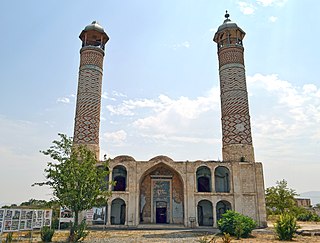
The Agdam Mosque or Juma Mosque is a mosque in the ghost town of Aghdam, Azerbaijan.
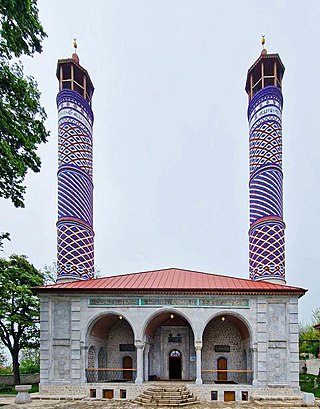
Yukhari Govhar Agha Mosque is a mosque located in the city of Shusha, Azerbaijan. The mosque also bears the name Boyuk Juma of Govhar Agha.

Haji Alakbar Mosque was an Azerbaijani mosque located in Fuzuli, Azerbaijan. The mosque is also spelt as Haji Alekber Mosque. The Haji Alakbar mosque was constructed in 1890 by the renowned architect of the time Karbalayi Safikhan Karabakhi who also built Yukhari Govhar Agha Mosque and Ashaghi Govhar Agha Mosque in Shusha, Aghdam Mosque in Aghdam, mosques in Horadiz and Qocahmadli villages, Tatar mosque in Odesa, Ukraine, and Qababaghlilar Mosque in Ashgabat, Turkmenistan. This monument of Islamic architecture is among 300 religious monuments of Karabakh and is famous for its structure along with Qiyas ad Din Mosque, also located in Fuzuli. Fuzuli, along with the Haji Alakbar Mosque was occupied by Armenian forces in 1993, and its condition was unknown during the occupation. However, after the recapture of the city by Azerbaijan, it was found to be destroyed.

Saatli Mosque is a mosque located in Shusha, Azerbaijan. It was under control of Armenian forces since the capture of Shusha on May 8, 1992, until the city's recapture by Azerbaijan on 8 November 2020.
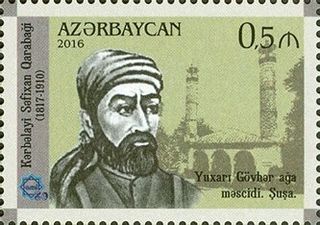
Karbalayi Safikhan Karabakhi was an Azerbaijani architect and one of the representatives of Karabakh architecture schools. Buildings by Kerbalai Sefikhan Karabagi included traditional and romantic elements. Designs of Karabagi, such as those for mosques in Aghdam and Barda, employ simple devices based on Azerbaijani architectural traditions.
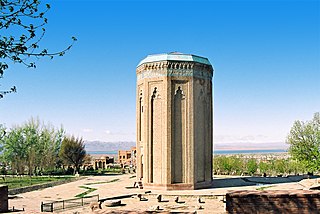
The architectural school of Nakhchivan is one of architectural schools developed in medieval ages on the territory of modern Azerbaijan. It was founded by Ajami Nakhchivani in the 12th century. The mausoleums of Yusif ibn Kuseyir and Momine Khatun, constructed by him in Nakhchivan are a classical example of constructions of this school.

Imamzadeh Mausoleum or Goy Imam Mosque is located 7 km northward to Ganja. It consists of a complex including walls with entrances, small mosques and funerary monuments. The mausoleum, located inside the mosque, bears the grave of Imamzadeh Ibrahim, son of Imam Muhammad al-Baqir, the fifth Imam of Shi'a Muslims.

Imamzadeh - is a complex in Nakhchivan (Azerbaijan), located nearer to other monuments of the city, on the coast of the Aras River.

Bahman Mirza Qajar Mausoleum is a mausoleum with three domes located 25 meters north-east from Imamzadeh architectural complex in Barda.
Imamzadeh Mausoleum is mosque on the Imamli street in the central part of the city of Shamakhi. The mosque was registered by Ministry of Culture and Tourism of Azerbaijan Republic as a historical and cultural monument of the country.

Shahbulag Mosque is a historical and architectural monument located in the area called Shahbulag in the Agdam region of Azerbaijan. The mosque was built by order of Panah Ali Khan in 1751–1752.
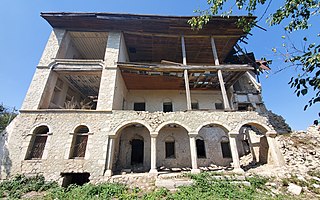
The Zohrabbayovs' house is a 19th-century building that belonged to the representative of the noble Shusha family of the Zohrabbayovs, to Abbasgulu bey Zohrabbayov.

The Mehmandarovs' House or Yesai Gharamyants House is a historic palace-type residential complex located in Shusha. It is one of the most interesting examples of the 18th century's civil architecture of Karabakh. The residential complex, which originally belonged to the Armenian Lieutenant Yesai Gharamyants during the 19th century, came into the possession of the Mehmandarov family in 1918. It includes the Large Residential Building, the Small Residential Building and the Family Mosque. The complex is fenced with stone walls. It was previously the site of the Shusha Museum of History.

Shirin Su bathhouse or the Bathhouse of the Fresh Water is a historical monument located in the city of Shusha. It was built in 1878–1880 at the order of Khurshidbanu Natavan by the architect of Kerbelayi Sefikhan Garabaghy. On 2 August 2001, the Cabinet of Ministers of the Republic of Azerbaijan, by the Resolution No. 32, registered it as a historical monument of a republican significance.
Caravansary of Safarov brothers is a caravansary built in Shusha in the 19th century. It is located in Khoja Marjanlı neighborhood. The monument, which belongs to the 19th century, is considered a republican architectural monument of the Republic of Azerbaijan. After the occupation of the city of Shusha by the Armenian armed forces, the building of the caravanserai was destroyed. Currently, its ruins remain.

















